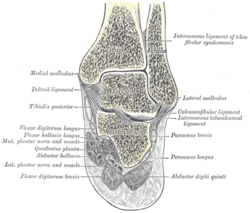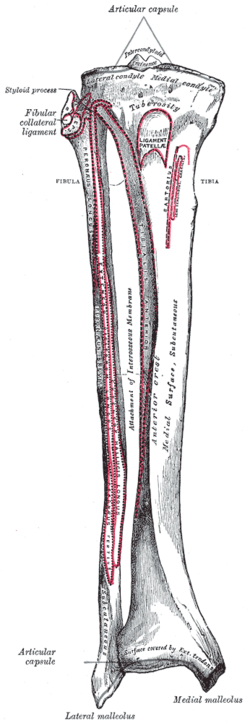Malleolus
| malleolus | |
|---|---|
 Coronal section through right talocrural and talocalcaneal joints. | |
 Back of left lower extremity. (Medial malleolus labeled at bottom right.) | |
| Details | |
| Identifiers | |
| Latin | malleolus, malleoli |
| TA |
A02.5.06.020 A02.5.07.014 |
| Look up malleolus in Wiktionary, the free dictionary. |
A malleolus[help 1] is the bony prominence on each side of the human ankle.
Each leg is supported by two bones, the tibia on the inner side (medial) of the leg and the fibula on the outer side (lateral) of the leg. The medial malleolus is the prominence on the inner side of the ankle, formed by the lower end of the tibia. The lateral malleolus is the prominence on the outer side of ankle, formed by the lower end of the fibula.
Medial malleolus
The medial surface of the lower extremity of tibia is prolonged downward to form a strong pyramidal process, flattened from without inward - the medial malleolus.
- The medial surface of this process is convex and subcutaneous.
- The lateral or articular surface is smooth and slightly concave, and articulates with the talus.
- The anterior border is rough, for the attachment of the anterior fibers of the deltoid ligament of the ankle-joint.
- The posterior border presents a broad groove, the malleolar sulcus, directed obliquely downward and medially, and occasionally double; this sulcus lodges the tendons of the Tibialis posterior and Flexor digitorum longus.
- The summit of the medial malleolus is marked by a rough depression behind, for the attachment of the deltoid ligament.
Structures that pass behind medial malleolus deep to flexor retinaculum:
- Tibialis posterior tendon
- Flexor digitorum longus
- Posterior tibial artery
- Posterior tibial vein
- Tibial nerve
- Flexor hallucis longus
Lateral malleolus
The lower extremity of the fibula, also called the distal extremity or external malleolus, is of a pyramidal form and somewhat flattened from side to side; it descends to a lower level than the medial malleolus.
- The medial surface presents in front a smooth triangular surface, convex from above downward, which articulates with a corresponding surface on the lateral side of the talus. Behind and beneath the articular surface is a rough depression, which gives attachment to the posterior talofibular ligament.
- The lateral surface is convex, subcutaneous, and continuous with the triangular, subcutaneous surface on the lateral side of the body.
- The anterior border is thick and rough, and marked below by a depression for the attachment of the anterior talofibular ligament.
- The posterior border is broad and presents the shallow malleolar sulcus, for the passage of the tendons of the Peronæi longus and brevis.
- The summit is rounded, and gives attachment to the calcaneofibular ligament.
Additional images
 Bones of the right leg. Anterior surface.
Bones of the right leg. Anterior surface. Back of left lower extremity.
Back of left lower extremity. Lateral aspect of right leg.
Lateral aspect of right leg.- Dorsum of Foot. Ankle joint. Deep dissection
- Dorsum of Foot. Ankle joint. Deep dissection
- Ankle joint. Deep dissection. Anterior view.
- Ankle joint. Deep dissection. Lateral view.
- Ankle joint. Deep dissection.
- Ankle joint. Deep dissection.
- Ankle joint. Deep dissection.
- Ankle joint. Deep dissection.
- Ankle joint. Deep dissection.
- Ankle and tarsometarsal joints. Bones of foot.Deep dissection.
- Ankle and tarsometarsal joints. Bones of foot.Deep dissection.
- Ankle joint. Bones of foot.Deep dissection.
- Ankle and tarsometatarsal joint. Deep dissection.Anterior view
See also
Notes
References
- ↑ "Malleolus". Merriam-Webster Dictionary. Retrieved 2016-01-22.
- ↑ "Malleolus". Oxford Dictionaries. Oxford University Press. Retrieved 2016-01-22.
This article incorporates text in the public domain from the 20th edition of Gray's Anatomy (1918)